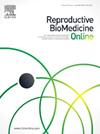结构重排携带者的PGT囊胚的衍生性和非衍生性非整倍体率。
IF 3.7
2区 医学
Q1 OBSTETRICS & GYNECOLOGY
引用次数: 0
摘要
研究问题:在进行着床前结构重排基因检测(PGT-SR)时,获得整倍体胚胎的可能性有多大?设计:回顾性分析364对夫妇(2822例营养外表皮活检)的PGT-SR数据,这些夫妇的易位(RecT, n = 263)、罗伯逊易位(RobT, n = 79)或倒置(Inv, n = 22)。每个周期对整倍体、衍生非整倍体或非衍生非整倍体的比率进行评估,并按重排类型和亲本来源分层。结果:Inv的整倍体胚率最高(47.0 ~ 52.5%),其次是RobT(34.1 ~ 45.2%)和RecT(24.0 ~ 28.2%)。与年龄匹配的对照组相比,RobT和RecT携带者的整倍体胚胎率显著降低(57.6% -59.0%)。与父系重排相比,母系重排在RobT(41.6%对20.2%)和RecT(60.2%对52.7%)中衍生性异常发现的比例明显更高。涉及其他染色体的非整倍体在重排携带者(38.1-41.9%)和年龄匹配对照组(40.6-42.4%)之间的频率差异不显著。结论:本研究的数据表明,在所有染色体重排携带者中,Inv携带者的整倍体胚胎率最高,母体重排导致胚胎异常的风险更高,并且在本队列中不存在染色体间影响非整倍体发生率的证据。通过对2700多例PGT-SR活检的分析,可以生成根据易位类型、原籍父母和活检次数分层的转移可能性表,这可以用来帮助建议患者进行PGT-SR。本文章由计算机程序翻译,如有差异,请以英文原文为准。
Derivative and non-derivative aneuploidy rates in PGT tested blastocysts from carriers of structural rearrangements
Research question
What is the likelihood of having an euploid embryo when undergoing preimplantation genetic testing for structural rearrangements (PGT-SR)?
Design
PGT-SR data from 364 couples (2822 trophectoderm biopsies) with a reciprocal translocation (RecT, n = 263), Robertsonian translocation (RobT, n = 79) or inversion (Inv, n = 22) were analysed retrospectively. Rates of euploid, derivative aneuploid or non-derivative aneuploid were evaluated for each cycle, stratified by the type of rearrangement and parent of origin.
Results
Inv had the highest rate of euploid embryos (47.0–52.5%), followed by RobT (34.1–45.2%) and RecT (24.0–28.2%). The rates of euploid embryos were significantly lower for carriers of RobT and RecT compared with age-matched controls (57.6–59.0%). Maternal versus paternal rearrangements had significantly higher rates of derivative-abnormal findings for RobT (41.6% versus 20.2%) and RecT (60.2% versus 52.7%). Aneuploidies involving other chromosomes did not differ significantly in frequency between rearrangement carriers (38.1–41.9%) and age-matched controls (40.6–42.4%).
Conclusions
Data from this study demonstrated that Inv carriers have the highest rates of euploid embryos among all carriers of chromosomal rearrangements, that maternal rearrangements confer a higher risk of abnormal embryos, and that evidence for an interchromosomal effect on aneuploidy rates was not present in this cohort. This analysis of over 2700 PGT-SR biopsies enabled generation of likelihood-of-transfer tables stratified by type of translocation, parent of origin, and number of biopsies, which can be used to help counsel patients pursuing PGT-SR.
求助全文
通过发布文献求助,成功后即可免费获取论文全文。
去求助
来源期刊

Reproductive biomedicine online
医学-妇产科学
CiteScore
7.20
自引率
7.50%
发文量
391
审稿时长
50 days
期刊介绍:
Reproductive BioMedicine Online covers the formation, growth and differentiation of the human embryo. It is intended to bring to public attention new research on biological and clinical research on human reproduction and the human embryo including relevant studies on animals. It is published by a group of scientists and clinicians working in these fields of study. Its audience comprises researchers, clinicians, practitioners, academics and patients.
Context:
The period of human embryonic growth covered is between the formation of the primordial germ cells in the fetus until mid-pregnancy. High quality research on lower animals is included if it helps to clarify the human situation. Studies progressing to birth and later are published if they have a direct bearing on events in the earlier stages of pregnancy.
 求助内容:
求助内容: 应助结果提醒方式:
应助结果提醒方式:


